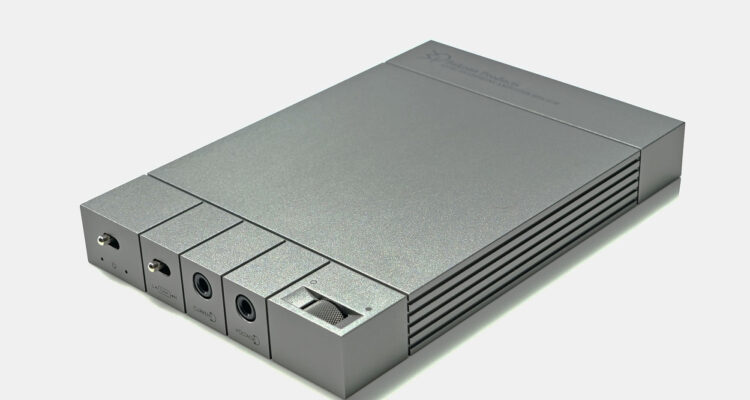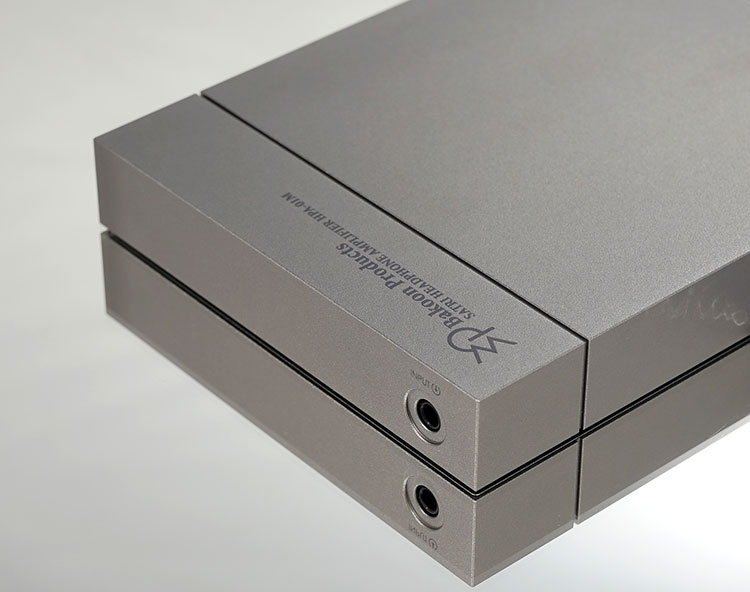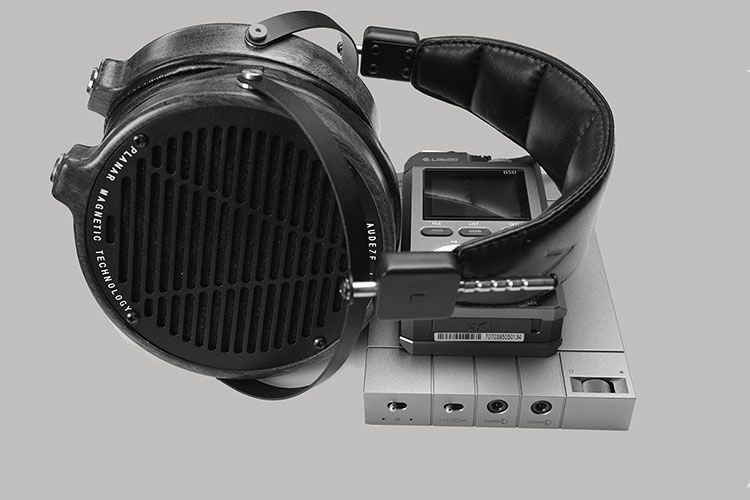The Bakoon HPA-01M is a new current-mode designed dual output portable analog amplifier. It is priced at $1295.
Disclaimer: The Bakoon HPA-01M sent to us is a sample in exchange for our honest opinion. We thank the team at Bakoon for giving us this opportunity.
You can read more about portable amplifier products we reviewed on Headfonics by clicking here.
There is nothing worse than getting a dose of the “man flu” when you are in mid testing, especially when the unit for review is the all-new portable HPA-01M current drive amp from Bakoon. You really just have to sit there and wait it out while staring at a $1295 portable behemoth that could very well be my portable amplifier of the year.
Unfair I cried and spent 3 days poking Candy Crush on my iPad (still stuck on level 168 I might add) as my nose, then my ears all got congested. I spoke to Sonny Trigg of Inearspace a few days ago and I mentioned to him that ‘man flu” is the mortal enemy (tinnitus excepted) of headphone review people or just headphone lovers in general.
We both agreed. Our ears are our tools and without them, the Bakoon seemed more like a beautiful paperweight than the revelation that might just bring back the pomp and splendor of the portable analog stacking days.
Bakoon
For those who have no clue who Bakoon is, they hail from South Korea and have developed a fine reputation for current drive amplification since the mid-1990s in SE Asian before broadening out to global via their offshoot, Bakoon Products International in 2009.
They are highly respected both for their engineering know-how and their panache for putting out some great audiophile desktop amplifiers and DAC’s such as the HPA-01, HPA-21, and the AMP-11R.
But one thing was missing from their lineup and that is something dear to our own hearts – a portable amplifier. True enough in late 2014, Bakoon reached out to us to let us know that indeed they are creating such an amp and named it the HPA-01M.
That same current drive amplification which Bakoon term as the SATRI circuit is now slimmed down reorganized and squeezed into a much smaller portable package along with a dual 8.4V Li-Ion battery setup rated up to 8 hours on the go.
It is not the smallest, certainly not the lightest but it is one heck of a classy looking solid metal amplifier and those who loved mid-90’s Meridian CDP designs will certainly appreciate the lines and form factor of the HPA-01M.
SATRI explained (possibly)
SATRI Circuit design works quite differently to typical technology you find in 99.9% of your desktop and portable amplifiers. It is one of the key reasons that make Bakoon products unique. We had reviewed Questyle’s CMA800 and their current drive set up last year but the Bakoon guys do it a bit differently.
Key Characteristics
The key characteristics of the SATRI circuit design should be a simpler circuit design around their resistor technology. Through two resistors (input/output) and their SATRIC-IC this setup eliminates the need for traditional voltage-based added circuit designs to filter the signal and in doing so it reduces common noise problems you would find in the traditional voltage-based circuit designs.
The benefits of such a design, quite apart from lower noise, should also mean a better signal to noise ratio and a fairly robust response to almost any source input and an excellent and powerful but very well balanced output response, particularly for headphones.
IEM Usage
I should point out though that for IEM’s though the effect of using current drive technology such as the simplified SATRI circuit in the HPA-01M may not be to your liking if you listen at very low volume as the L/R balance is uneven until you get to low/mid-levels. Beyond those low levels though there are zero issues. I spoke to GM of Bakoon Soo In Chae on why the choppy waters for IEM users at low volume and he gave his explanation thus:
Regarding your question on the channel imbalance, we’re fully aware of this and this is due to our circuit characteristics. The SATRI Circuit controls overall gain at the very end of input stage, unlike conventional circuits which control gain at the beginning of input stage, which has its biggest disadvantage that it also affects/reduces S/N ratio (or signal “purity”) from the beginning.
Our circuit reserves S/N ratio all the way and since the input signal is at full from the beginning to the end, yet only controlled by the potentiometer’s resistance at the end, it directly follows the potentiometer’s resistance characteristics, which always has greater resistance imbalance at the beginning (or at low resistance). Therefore, for high sensitive IEMs, it is the best to use low gain on current output, at which users can control the gain at “safer” region.
In order to drive wide variety of earphones and headphones, the current gain setting was our choice for the HPA-01M, which will also meet very demanding headphones available today.
So there are plus and negative points depending on your desired usage with the HPA-01M but I would not give overdue importance to the low volume channel imbalance as I found out during testing nearly all cases where high sensitivity is a factor (customs, IEM’s) that imbalance faded away rather quickly on low gain and the results beyond a few turns on the pot were very satisfying.
Form Factor
For those who have seen their previous amplifiers or tinkered with them will know there is a heck of a lot of transistors packed into each amp, particularly on the latest board design, the SATRI-IC-EX.
That entire design for the HPA-01M was miniaturized and re-thought to fit into a shell designed out of a single aluminum block and roughly half the volumetric size of the original HPA-01M. So it is neither the most pocketable, nor the lightest weighing in at around 1kg but I personally find the form factor and build quality to be really tight, solid and assuring.
It kind of reminds me of high-end electronics in the ’90s from the outside. The added weight feels assuring. A rather illogical assumption that if it is heavy it must be good.
Comparisons
Compared to the HPA-01M, the Theorem 720 and Duet from Cypher Labs feel like featherweights with only the similar priced Aurender Flow looking bigger and weighing the same or a bit more. I understand when the concept art first came out a lot of people thought the front panel to be modular in design, a sort of Phone Bloks for the audiophile.
Those grooved lines certainly look detachable on 2D. Sadly, or wisely, depending on your view, that is not the case but rather it is more of design flair in an otherwise homogeneous block of solid metal.
This particular metal came in a gunmetal flavor also. There are three colors for you to pick from at the time of writing – black, silver and gunmetal. Having seen all three pre-production units that gunmetal really stood out from the crowd. It is a personal choice, some will opt for black and others silver but this one matched well with a lot of DAP’s I am using as well as my desktop.
Functionality
Given it is an analog headphone amp you will not find a plethora of buttons and digital effects and thankfully so. However, the HPA-01M does come armed with a power on/off switch, a low/high gain switch and two 3.5mm outputs; one of which is the current drive output and the second is a voltage drive output.
Now having recanted the benefits of current amping you might be surprised to see a voltage output on the amp but after ample testing, both outputs are welcome given both outputs to offer quite a different response and sound signature.
Charging
To the left side, you have also your AC input for charging and at the back is the analog 3.5mm input for your source signal. It was initially at the side where the AC input is but after much discussion and many a head-fier and other bloggers Bakoon decided that it should be at the back.
A wise decision as the front and side of the amp is blissfully clutter-free when wired up as well as DAP positioning (up or down) being largely irrelevant in the long run. The consequences of a side analog input for portable purposes would have been awkward, to say the least.
The charging cycle of the HPA-01M is approximately 2-4 hours depending on your desired capacity. Two hours will get you 80% and 4 will take it all the way up to 100%. Charging is AC only and the charger is not insubstantial.
You can listen to the amp during charging but be warned I found during testing that this impaired the charging process significantly to the point where I got around 30 mins or less playback time despite the charger showing a green LED indicating a full charge. Better you switch it off and go sleep in a cave and come back in 4 hours to enjoy that 100% which is, as described, around 7-8 hours.
The Pot
The volume pot is set in slightly from the front panel and protected by a front guard machined from the same aluminum block as the rest of the unit. The guard, as in the Cayin C5 and the FiiO E18, does a great job of protecting from accidental volume hikes when moving around but it is much sturdier than the two cheaper amps in question and of much higher quality in the finish.
Sadly there is no indication on the pot of volume levels (1-10 etc) and the only sign that you are starting at “0” is the small star screw that is visible right at the lowest level. The amp will not magically restart at a desirably safe low level so make sure this little screw can be seen before turning it on.
There is nothing flakey about the gain and power switches either. Both are of very high-quality aluminum chrome painted finish and not likely to break off under pressure or continued usage.
What else?
Apart from that, you get two rather standout white rubber bands with the Bakoon motto “Ears and Years” for stacking stability which doubled nicely as cushioned rubber feet when on a desktop and a 3.5mm right-angled Cardas HPI 6cm IC in black.
The box itself is nothing remarkable, more of a brown box with a few stickers on it but it does the job safely and securely and Bakoon does ask you to keep it in case of possible returns or warranty repairs. On the side of the box, you do get your units serial number sticker which should match the one on the underside of the amp itself.
Sound Impressions
The HPA-01M has essentially two sound profiles on offer that will suit different tastes. The current drive output and the voltage drive output do not sound the same and do not operate at the same volume or gain levels either. They match differently to some gear also with differing responses. It really is a case of two halves as a result. There are some defined commonalities such as that little bit of channel imbalanced prevalent on sensitive cans and earphones and general power capability with planars (their ideal match) but that is about it.
Current Drive Output
With the current drive output, you get more of a reference level and very transparent and natural sound that scales wonderfully well especially with planar headphones. Tonality is neutral, fast, clean and relatively linear right the way throughout. The dynamics and detail are excellent whilst never sounding too tiring or forward. Attack and decay are tight but refined so there is never a hint of anything harsh unless the recording is poor. This is the more revealing of the two outputs and as such the one I would channel my better recordings through and anything complex and articulate.
The current drive output is practically color free. When I mentioned transparency that is not some vague description of detecting quirks in a recording that some amps veil over but rather the fact each source I tried was instantly recognizable in its own right but with the benefit of some quality reference amping.
I went through about a ton of different portable sources such as the DX90, AK120, Lotoo’s Paw Gold, Shanling’s M3 and the FiiO X5 and each signature could be clearly detected via the Bakoon’s current drive signal. Some obviously performed better than others – after all this is an analog setup so line outs are critically important with the HPA-01M unless you go for double amping.
Achilles Heel
The Achilles heel is the relative channel imbalance with sensitive headphones and IEM’s at low levels of output, especially if your source line out is powerful in its own right such as the Paw Gold. At absolute zero the sound was not dead quiet. Not to be confused though with background noise or hiss, not a hint of it, rather just the playback level couldn’t hit zero properly even on low gain.
IEM’s such as the VE6X from Vision Ears, Custom Arts Harmony 8 and more mid-fi UE900s’s all had that low-level imbalance. It is really unavoidable given the explanation regarding how current signal works. Push it up a few notches though to regular listening levels and all IEM’s sound perfectly fine with no imbalance. It is slight nitpicking perhaps but something to be aware of.
Voltage Drive Output
In most instances, the voltage drive had a weightier and fuller sound than the current signal. To those coming from traditional amping this signature might seem more familiar and possibly more consumer-friendly with that added bass bias, slightly slower decay rate and an elevated hint of warmth to take the edge off on the top end. When I say slightly slower it is still by accounts a relatively speedy signature but compared to the current drive you can feel it take its foot off the gas ever so slightly.
Voltage drive’s slightly slower decay rate and lower levels of separation than current drive might also make the sound a bit more congested, thicker and with less space adding to the sensation of having a weighted lower mid to upper bass signature. It is also not as linear as the current drive output, especially in the bass response, it is more of a fun signature for modern rock and pop genres and more forgiving in general of compressed or lossy recordings.
Whilst my own personal preference veered to the overly neutral and speedy current drive for the likes of say prog rock, orchestral, speed metal and acoustics, I did enjoy switching to voltage drive for EDM, pop and hard rock just to color the response a bit more and elevate the bass ever so slightly.
Click on Page 2 below for synergy and verdict




